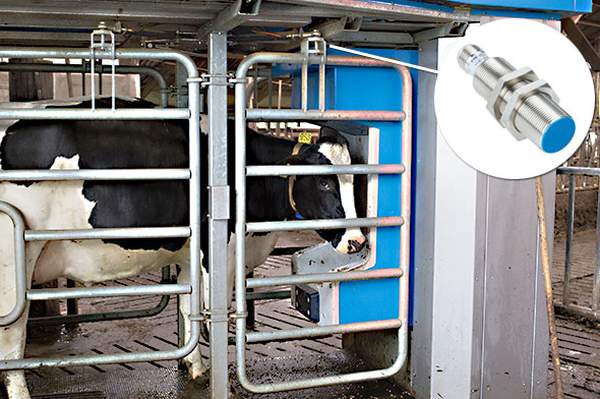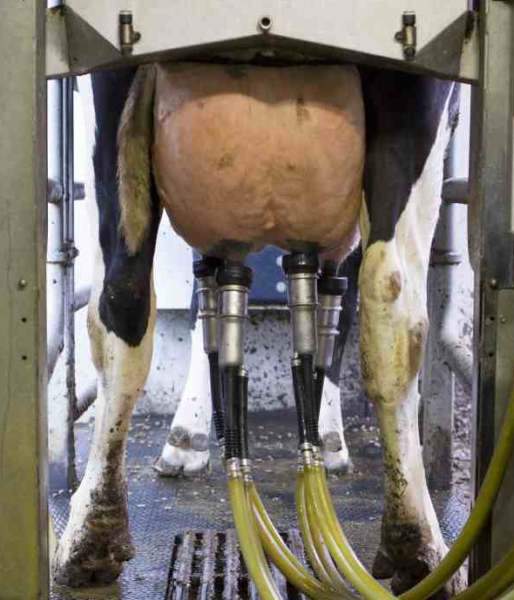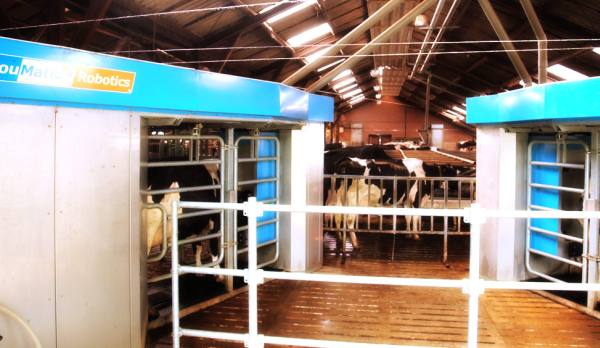There is not a farmer in sight in the Van Aart family's barn. Yet the cows are still standing in line to be milked. Ever since the two MR-S1 milking robots arrived from BouMatic Robotics in Emmeloord, the cows can be milked whenever they like. And the farmer? He pops in twice a day to refill the feed or clean the robots, for example, but otherwise this part of the farm runs without him having to do anything. SICK sensors are keeping an eye on things.

Everything for the Welfare of the Animals
In the Van Aart family's barn, Sales Manager Van de Pol points out the line of cows waiting at the MR-S1: "It's amazing how quickly the cows find their way to the milking robots. We encourage this by giving them concentrated feed, plus the cows themselves want to get rid of the pressure of the milk. The robot is ready to use around the clock, so the cows can decide for themselves when they want to be milked. This results in an enormous improvement in their wellbeing". Van de Pol adds: "Cows are real creatures of habit. Once they have found their routine, they often come for milking at the same time the next day. You can see here that this cow comes along at exactly seven o'clock in the morning every day." Thanks to a transponder on the cow's neck, the milking robot knows exactly which cow it is currently dealing with. At the same time, the transponder ensures that the cows that have actually just been milked, but just want a second helping of feed, are sent away again.
SICK monitors the milking process
Lots of SICK blue can be seen in the milking robots. For example, the inductive sensor monitors whether or not the barrier is closed.


While the absolute encoder signals the precise position of the robot arm. Van de Pol: "What sets our milking robots apart is that the robot arm goes between the back legs of the cow. From washing the udders and pre-milking to the actual milking process and disinfection, all working steps are carried out by the robot arm between the back legs of the cow." This approach has a key advantage: "Cows always move forwards. If the udders are reached from the side then the cow may stand on the arm, meaning that faults would occur." 
The robot also monitors the milk quality. The cow's milk runs through a glass vessel, which is monitored by a SICK KT8 CAN bus sensor. "This sensor, which we call a blood sensor, monitors the level of red in the milk. If blood is detected then a valve opens immediately to drain away the milk", explains Van de Pol. The function of the valve is monitored using an induction sensor from SICK. "The valve has a very important role to play in terms of quality assurance. Cleaning agents and milk from cows that have been prescribed antibiotics must not reach the milk tank under any circumstances, because cattle farmers are not permitted to deliver this kind of contaminated milk. This would result in damaging losses."
About BouMatic Robotics
 Double stall milking robot.
Double stall milking robot.
Reference: www.boumaticrobotics.com
BouMatic Robotics is a young, growing company from the Netherlands. Founded in 2011 by an American investor, the operation is now one of the six key providers in the world. BouMatic Robotics is also in the process of building a solid customer base in Germany, Austria, Switzerland and Canada. This means that opportunities for growth are a long way from being exhausted, because with the introduction of the double stall milking robot, with which two cows can be milked at the same time, the robot manufacturers want to open up an even bigger market.
Video Milking robots:
- Product information: KT8 CAN Contrast sensor, IME12, IME18 Inductive proximity sensors, AFS/AFM60 Absolut encoder
- Product portfolio: Contrast sensors, Inductive proximity sensors, Absolut-encoders
- Customer information: Boumatic Robotics

